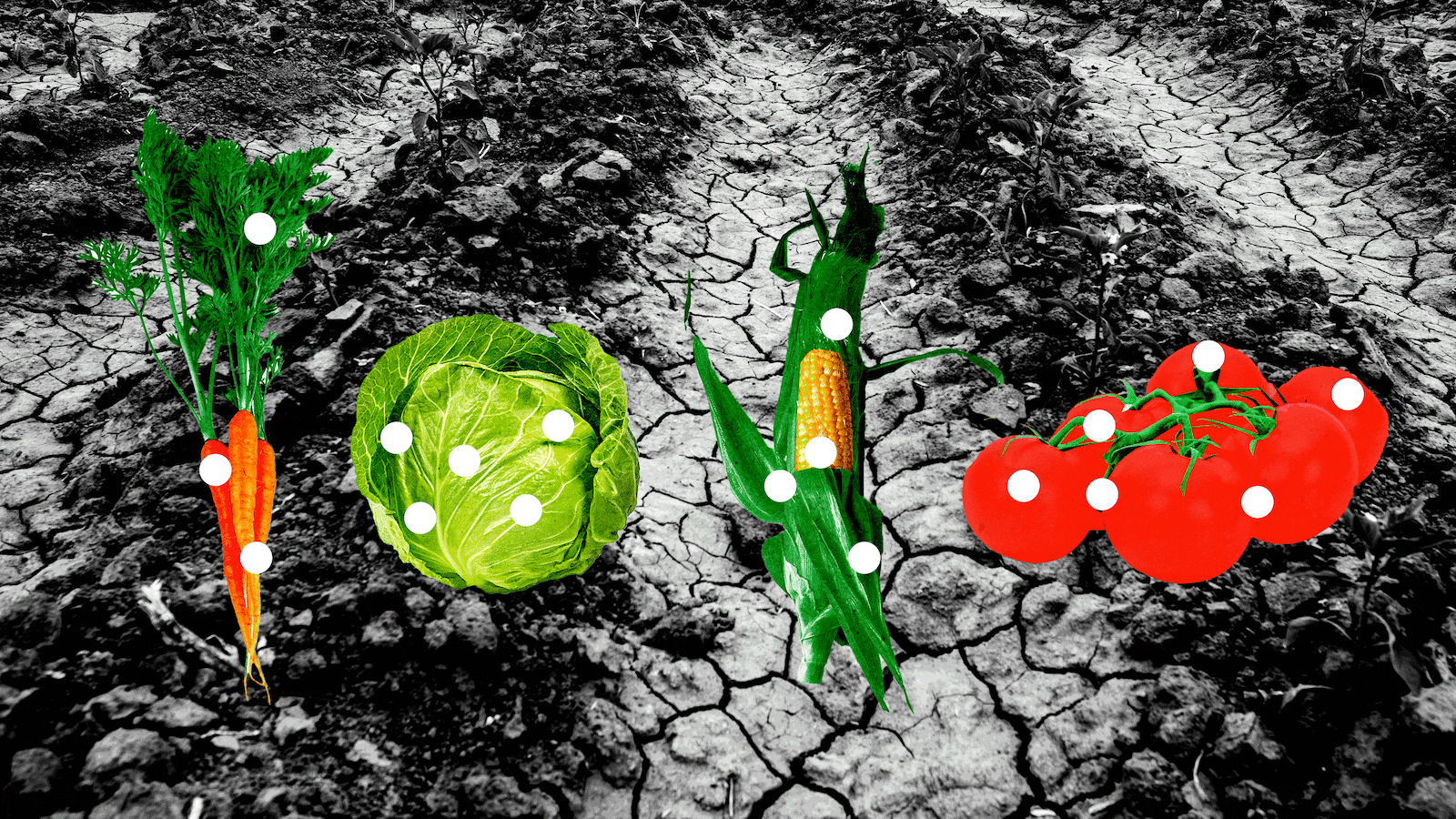The world’s population is growing rapidly, and current food production must increase by 70 percent in the next 30 years in order to feed everyone. Amid an unpredictable climate crisis that continues to stress crops via increased heat, drought, and unreliable or excessive rainfall, it’s especially important to be innovating in agriculture now.
In recent years, companies have focused on the rhizosphere, the area of soil surrounding a plant’s roots, as the target for added, beneficial microbes. You can find these products online or on shelves as “soil microbes for gardening,” but there’s little evidence that adding microbes to the soil will actually improve plant health. It’s a method that has worked to an extent, allowing for a plant to sometimes show increased nutritional uptake and growth, but according to researchers at University of Minnesota, “success depends on existing microbial communities” in the soil, not added ones.
But some are going a step further, adding naturally occurring and isolated microbes directly to plant seeds via a coating or treatment process which allows a plant to basically be born with an advantageous microbiome, with microbes already living within the plant’s tissues. And much like the human biologicals industry, the ag biologicals industry is booming—and for good reason.
They’re called endophytes, “an endosymbiotic group of microorganisms that colonize in plants and microbes,” and can be easily isolated from existing microbes and plants and applied, via laboratory technology (and what looks like a giant mixing bowl), to other ones. When a plant is born with an advantageous microbiome, or with microbes that have come from another plant that has lived in extreme conditions, they are more likely to survive similar extreme conditions, and to even thrive under them.
Microbes from these “survivor plants” ultimately improve stress tolerance and resiliency in plants to heat, drought, pathogens, and nematodes (plant-parasitic roundworms). The potential impact here, then, is a new generation of plants, of crops, that are more immune to abiotic, or environmental stressors, and more able to survive and ultimately provide food for a growing, global population that demands it.
One such company tackling the plant microbiome is Indigo Ag, an agricultural tech company that harnesses beneficial microbes, applying them to plant seeds to improve stress tolerance, resiliency, and yield for crops like cotton, wheat, soybeans, and rice.
“You can see the effect of the plants’ microbiome from outer space,” Geoff von Maltzahn, co-founder and chief innovation officer of Indigo Ag, told The Daily Beast. “Those insights and that data from satellites that watch the world have allowed us to start to build a living map of the whole world’s food supply.”

Geoff von Maltzahn, co-founder and chief innovation officer of Indigo Ag.
Courtesy of Flagship PioneeringVon Maltzahn says their point of inspiration for exploring the plant microbiome was, in fact, the human microbiome. “We realized if there is this connection between the human microbiome and our health, there’s probably a connection present between a plant’s microbiome and its resiliency, and this is true for every single agricultural crop around the world,” he explained.
So, it started with the idea that maybe every agricultural seed has a microbiome on it. And then began the search for plants that had survived in harsh environments where other plants (even of the same species) had not.
“Just like probiotics can benefit our health, it turns out that there are microbes who are happiest when living inside of plants,” von Maltzahn said. “That can dramatically improve the resiliency of their host to a variety of stresses from drought stress to heat stress, nutrient stress, and those stressors from various pathogens.”
Since its inception, Indigo has collected over 50,000 microbes and has sequenced more than 17 billion base pairs. Because so little is known about the beneficial interactions between microbes and plants, this genetic sequencing makes available new information about the underlying mechanisms that exist between microbes and crop production. By identifying and isolating such a wide range of microbes, researchers and companies are able to meticulously assess which belong where, or which would be most beneficial for certain crops in certain areas—for example, corn in the Great Plains. Because different crops in different regions face varied conditions, this vast library of microbes is key to solving region-specific and crop-specific challenges. Using this method, the company took soybean crop yield tests in Brazil from 3 percent to 8 percent—a significant and immediate jump.
Despite the success Indigo is seeing now, there hasn’t been serious interest in researching the plant microbiome until pretty recently—though Scott Lowman, vice president and director of applied research at the Institute for Advanced Learning and Research, has been at it longer.
“The field of endophytic study, of the plant microbiome, really mirrors that of what we know about our own microbiome,” Lowman told The Daily Beast. “So, you know, 20 years ago, if you thought you had a bacteria inside of you, you’d try to get an antibiotic, but now we know we have lots of great bacteria inside of us, and so do plants.”
Lowman has researched the plant microbiome for the past twenty years and licenses strains of microbes for agricultural application and use. “Unlike GMOs, what we work with are natural microbes, isolated from nature, used as nature intended,” Lowman told The Daily Beast.
While pursuing his master’s, he began putting plants together with beneficial microbes in the lab, inoculating bacteria in sterile gels while watching the activity of their control plants, sans microbes. “Sometimes you’d see the plant with microbes applied be eight times larger than the control—and in agriculture, that’s just unheard of.”

“Sometimes you’d see the plant with microbes applied be eight times larger than the control—and in agriculture, that’s just unheard of.”
Courtesy of Scott Lowman, Ph.D.Lowman explained that, previously, you may get some increase in crop yield through breeding programs. But those increases (as much as 5 percent) can take 8 to 10 years to occur. That’s not the case with the microbe-treated crops. “Some of these microbes that we see interacting with plants are doubling production. And the time frame there? It’s immediate,” he said.
Just 10 years ago, the major players in the field were focused on GMOs and modifying genes, but Lowman says those solutions are limited and have pretty much leveled off.
Lowman claimed that he has NDAs with several major companies all of whom are vying to get in on the action. With the increased need to protect crops and the consumer demand for pesticide-free food, it makes sense to see a shift toward biological innovations in the agricultural space. More so, if we don’t go this route, what options do we have?
According to NASA’s Global Climate Change sector, maize crops are projected to see a 24 percent decline by 2030, and citrus growers in Florida are already reporting a loss of 50 to 90 percent of their fruit thanks to Hurricane Ian, which barrelled through the state in late September. A sharp decline in food supply is exactly opposite of what’s needed in a world where population growth is only going up, and the implications from current data and trajectories are unsettling if there are no innovations in ag.

Some plants applied with the microbes appeared eight times larger than without.
Courtesy of Scott Lowman, Ph.D.“No. 1 is, we need new solutions to address climate change,” Lowman said. “And No. 2, a lot of fertilizers are based on fossil fuels which are not in the infinite supply.”
Our food system utilizes seeds that have been shipped around the world to farmers who are going to plant them in different conditions from where the parents of those seeds were planted. And because of that, it’s all the more important that those seeds receive a microbiome that’s acclimated to the stress profile and other conditions where they will be planted, borrowing the microbiome from their ancestors that will keep the most harmful stressors at bay.
“We want to get to a place where we no longer pile all food together and erase the variation of quality,” von Maltzahn said. “We can achieve a food system that is more natural, and more consistent with these ideals. It’s right beneath our feet.”







